From the vast nomadic steppes of Kazakhstan to the bustling streets of Hanoi, Asia is a land rich in adventure, peace, and spirituality—captivating and inspiring travelers for centuries.
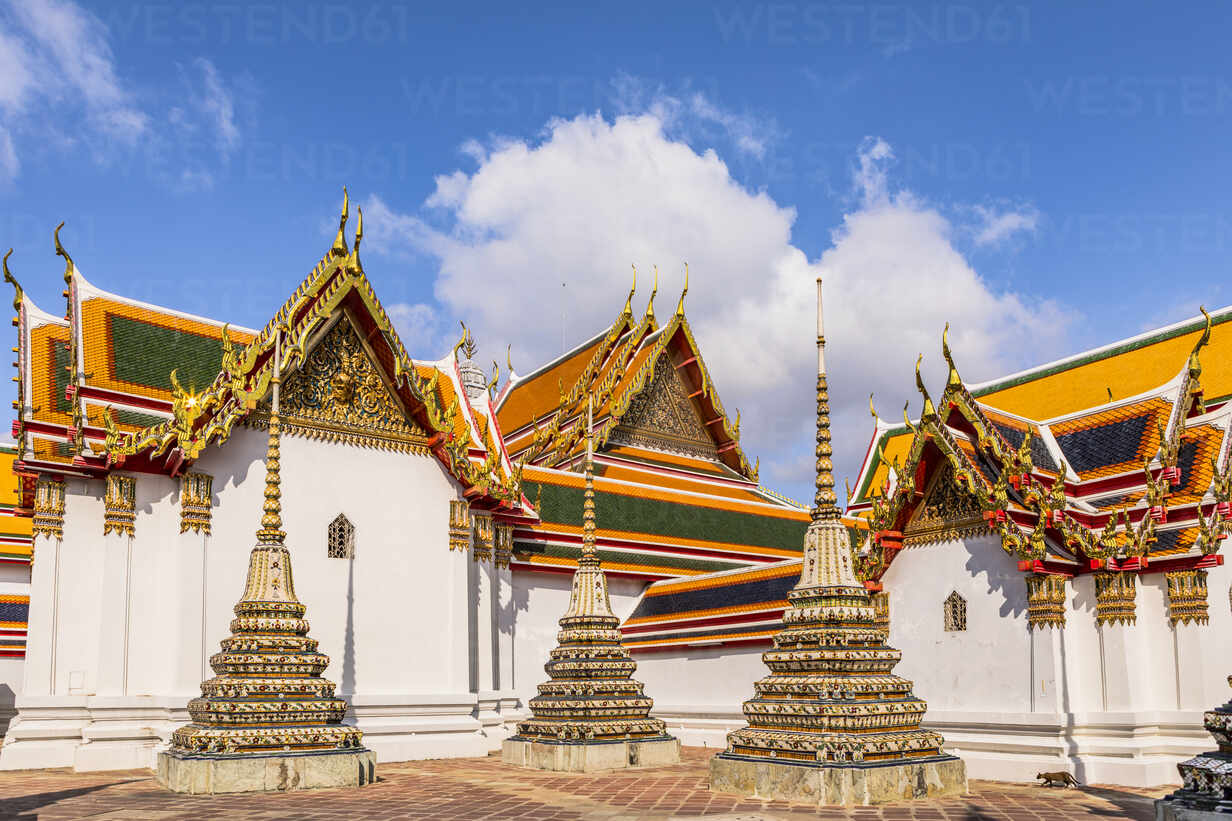
Wat Pho is hands down one of our favorite sights in Bangkok. This sprawling temple complex is home to several remarkable “firsts”: the city’s largest reclining Buddha, Thailand’s biggest collection of Buddha images, and the country’s earliest public education center.
The star attraction is the enormous Reclining Buddha—so massive it barely fits inside its pavilion on the western edge of the complex. It’s an awe-inspiring sight and typically less crowded than nearby Wat Phra Kaew, making for a more serene experience.
Spanning eight hectares, Wat Pho’s northern side houses its main tourist attractions, while the southern side holds monastic quarters. The temple also serves as Thailand’s national center for traditional medicine and Thai massage—a legacy of Rama III, who formalized its preservation when the art was fading.
Visitors can partake in a popular ritual by dropping coins into 108 bronze bowls behind the Reclining Buddha—each representing a blessing. Don’t worry if you don’t have coins—attendants can exchange notes for change.
Wat Pho, officially Wat Phra Chetuphon Wimon Mangkhalaram Rajwaramahawihan, dates back to the 16th century and was originally called Wat Phodharam. King Rama I restored the site in 1788 after building the nearby Grand Palace, establishing it as a vital spiritual and educational hub.
King Rama III expanded the complex in 1832, including the construction of the West Vihara to house the Reclining Buddha, which was completed in 1848. Built from a brick core and coated in gold leaf, the statue remains the largest in Bangkok.
It was also Rama III who transformed Wat Pho into Thailand’s first public university. The temple’s educational mission is reflected in the over 1,000 Buddha images and 1,431 stone inscriptions that teach history, literature, and traditional Thai knowledge—including Thai massage.
Wat Pho underwent a major restoration in 1982 for Bangkok’s Bicentennial celebration.
Opening Hours: Daily, 8:30 am–6:30 pm
Entry Fee: 200 Baht (includes a free bottle of water)
Dress Code: Wear clothing that covers shoulders and knees. Shoes must be removed at temple entrances—plastic bags are provided to carry them.
Wat Pho is one of the few sacred sites in the world where you can enjoy a massage. Home to the famous Thai Traditional Massage School, it offers both massage services and training:
Available Treatments: Thai massage and foot massage (30 or 60 minutes)
Booking: Via the Wat Pho Massage website
Courses: One-day classes start at 12,000 Baht; 30-hour basic courses are also available
Location: Within the temple grounds and in a separate facility nearby
Reclining Buddha:
This stunning 46m-long, 15m-high statue depicts Buddha’s entry into nirvana. Its feet are inlaid with mother-of-pearl showing 108 symbols of Buddha. A row of 108 monk bowls behind the statue offers visitors a chance to give alms.
Phra Ubosot (Ordination Hall):
A mix of Ayutthaya and Rattanakosin styles, it houses the temple’s second most revered Buddha image and the ashes of Rama I.
Gilded Buddha Images:
The galleries feature 394 Buddha statues from various Thai art periods. Look for Phra Chinnarat and Phra Chinnasri from Sukhothai in the western and southern chapels.
Ancient Inscriptions:
Surrounding the Phra Ubosot are bas-reliefs from the Ramakian (Thai Ramayana). UNESCO-recognized inscriptions detailing Thai medicine and massage further enrich the site’s educational heritage.
Royal Chedi:
Four grand stupas commemorate the first four Chakri kings. The middle chedi houses a towering 16m Buddha from Ayutthaya.
Phra Mondop:
A scripture repository guarded by demon statues (yaksha), believed to be the origin of the nearby Tha Tien area.
Sala Kan Parian:
One of the oldest structures in the complex, it predates Rama III and once served as the main ordination hall.
Scenic Grounds:
Discover rock gardens, a Bodhi tree grown from the original in Bodh Gaya, and whimsical statues of Khao Mor, credited with creating yoga.
Granite Guardians:
Chinese stone figures brought by sea serve as guardians of the temple. Among them are Chinese opera warriors and even Marco Polo in a fedora.
Arrive early to enjoy cooler weather and beat the crowds.
Explore beyond the Reclining Buddha—there’s so much more to see in the temple’s peaceful, almost maze-like grounds.
Pa Aew: A casual stall serving Bangkok-style curries and stir-fries.
Tonkin Annam: A highly rated Vietnamese restaurant offering Hue specialties and flavorful pho.
Chakrabongse Villas: A historic riverside retreat with a royal touch, beautiful gardens, and luxury accommodations.
Arun Residence: Located across from Wat Arun, this wooden house combines charming views with stylish rooms and a rooftop bar.
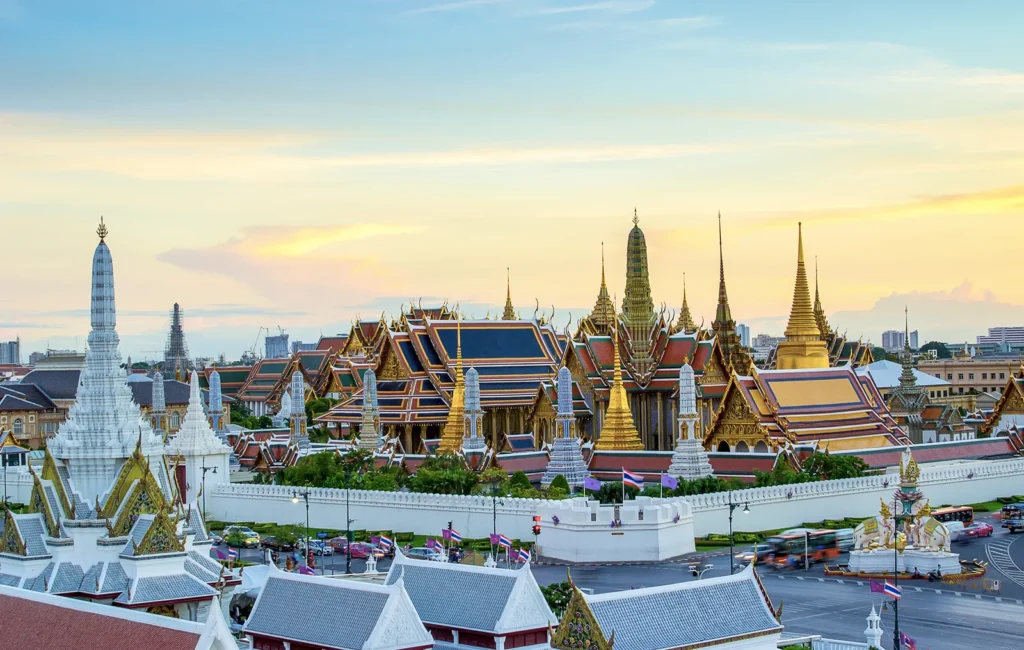
The Grand Palace (Phra Borom Maharatchawang) is one of Bangkok’s most iconic landmarks. Established in 1782, it served as the official royal residence for over 150 years. Today, while no longer a royal home, it remains the city’s most visited attraction and a sacred site for devout Buddhists.
Part of a larger complex that includes Wat Phra Kaew (Temple of the Emerald Buddha), the Grand Palace spans an impressive 94.5 hectares and comprises more than 100 buildings, showcasing over two centuries of Thai royal history and architectural evolution.
Most structures follow the traditional Ratanakosin style, though a few blend Western influences with Thai aesthetics. Visitors can explore the palace grounds and four remaining royal buildings—each a testament to the grandeur of Thailand’s monarchy.
Allow 2–3 hours for a thorough visit, or an extra hour with a guided tour for deeper insights.
Chakri Mahaprasat (Grand Palace Hall)
The largest structure open to the public, Chakri Mahaprasat was designed by British architect John Clunish in 1882. Its fusion of Italian Renaissance design with traditional Thai rooftops gave rise to the nickname farang sai chadah—”a Westerner wearing a Thai headdress.” Legend has it King Rama V chose the Thai-style roof over a Western dome to assert national identity during colonial times.
The central spire (mon·dòp) houses the ashes of former kings of the Chakri dynasty, while the side spires hold the remains of princes who never ascended the throne.
Dusit Hall
Situated to the west, Dusit Hall is a stunning example of Ratanakosin architecture. Once used for royal audiences and funerals, it embodies traditional Thai artistry.
Borombhiman Hall
This French-style building at the eastern end was once home to King Rama VI. Today, it’s closed to visitors but can be viewed through its ornate gates.
Amarindra Hall
Originally a court of justice, Amarindra Hall is now reserved for rare royal ceremonies—most notably, the coronation of the current monarch, Rama X, in 2019.
Inner Palace (not open to the public)
Once a harem guarded by elite female soldiers, the inner palace offers a fascinating glimpse into royal life. Its legacy is beautifully captured in Four Reigns, a historical novel by Kukrit Pramoj that follows a young girl growing up within the Royal City.
Founded by King Rama I in 1782, the Grand Palace was strategically positioned on the east bank of the Chao Phraya River for natural defense. The river served as a moat on three sides, while the swampy eastern edge deterred intruders.
Royal residence gradually shifted away from the Grand Palace during the reign of Rama VI. Chakri Mahaprasat Hall eventually fell into disrepair, with plans for renovation under Rama VII halted due to financial constraints.
In 1946, the palace was the site of a national tragedy—King Rama VIII was found dead under mysterious circumstances. Decades later, in 1981, an attempted military coup briefly used the complex as its base.
More recently, the Grand Palace was the site of King Rama IX’s lavish funeral in 2017, featuring a 50-meter-high golden crematorium and attended by tens of thousands. The coronation of Rama X followed in 2019, reaffirming the palace’s ceremonial significance.
Opening Hours: Daily, 8:30 am–3:30 pm
Entry Fee: 500 Baht (includes access to Wat Phra Kaew and Queen Sirikit Museum; free for Thai nationals)
Entrance: Enter through the third gate from the river pier
Tickets: Available on-site or via the Royal Grand Palace website
Audio Guides: 200 Baht; guides also available at the ticket booth
Accessibility: Wheelchair-friendly paths and accessible toilets are available
Visitors must wear culturally appropriate clothing:
Long trousers or skirts
Sleeved shirts (no sleeveless tops or vests)
No shorts, ripped jeans, cycling shorts, or transparent clothing
Inappropriate attire will require a sarong rental at the gate—expect queues. Footwear is flexible, though you’ll need to remove your shoes to enter some buildings.
Arrive early to beat the heat and the crowds
Ignore touts near the gate claiming the palace is closed
Bring water—there’s limited shade and no functioning cafeteria onsite
Ming Lee
Just outside the main entrance, this local Thai restaurant offers flavorful, no-fuss dishes in an old-school setting.
Navy Club
Run by the Royal Navy Association, this riverside eatery is known for affordable seafood and scenic views—not so much for ambiance.
Err
Enjoy Thai-inspired cocktails and creative snacks in a laid-back, modern setting near the palace.
Asadang House
Step back in time at this nine-room guesthouse in Chinatown. Rooms are cozy, furnished with antiques, and come with modern comforts.
Feung Nakorn Balcony
Housed in a former school, this peaceful hotel features spacious rooms around a leafy garden courtyard, offering a quiet stay near the Grand Palace.
Arom D Hostel
In the vibrant Tien village area, Arom D offers design-forward rooms, a rooftop deck, communal spaces, and an in-house café.
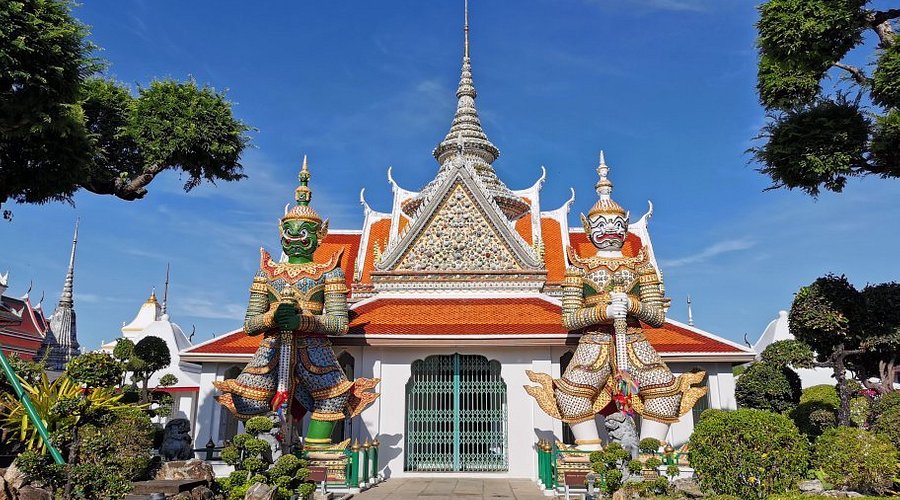
Rising like a spire of light from the western bank of the Chao Phraya River, Wat Arun—named after the Indian god of dawn, Aruna—is one of Bangkok’s most striking and enduring landmarks. King Taksin is said to have arrived at the site at sunrise after the fall of Ayutthaya in 1767, interpreting the appearance of a local shrine as a divine sign to establish the new Siamese capital here.
Wat Arun is unlike most other temples in the city—climbing its towering central prang is not only allowed, it’s encouraged. The views from the top, looking out over the winding river and the old city beyond, are among the best in Bangkok.
The temple’s iconic 82-metre prang (Khmer-style tower) was added in the early 19th century, initiated by Rama II and completed during the reign of Rama III. The tower’s unique look comes from its intricate floral mosaics, created from shards of multicoloured Chinese porcelain—cargo ships once discarded this porcelain as ballast, and temple builders found creative use for it.
Inside, the main Buddha image is said to be the design of Rama II himself. The interior murals, completed under Rama V, include a particularly poignant scene of Prince Siddhartha encountering birth, old age, illness and death—a moment that catalyzed his journey toward enlightenment. Beneath the main Buddha image lie the ashes of Rama II.
History of Wat Arun
A temple has stood on this site since at least the late 16th century, originally named Wat Makok. Its historical importance rose when King Taksin encountered the temple at dawn, giving it the name Wat Chaeng and designating it as his royal temple. For a time, the revered Emerald Buddha was housed here before being moved across the river to Wat Phra Kaew in the Grand Palace complex.
Rama II renamed the temple Wat Arun and began work on the main prang, which was later completed by Rama III in 1842. Since then, the temple has changed little, aside from recent restoration work on the central tower, completed in 2017.
Visiting Wat Arun
Wat Arun is open daily from 8am to 6pm. Entry costs 50 Baht. It sits just across the river from Wat Pho, making it easy to combine both temples in a single visit.
While many choose to visit via long-tail boat tours, getting there is simple by public transport. The cross-river ferry from Tien Pier (operating 5am to 9pm) is quick and cheap. The Chao Phraya Express Boat also serves this stretch of the river.
What to See at Wat Arun
The Spire (Prang)
The central prang stands 82 metres tall and is covered in thousands of tiny, colourful porcelain tiles arranged into delicate floral patterns. Up close, the detail is remarkable. Visitors can climb the steep staircase for a panoramic view of the Chao Phraya and the city skyline.
The Ordination Hall (Ubosot)
The main ordination hall houses a Buddha statue believed to be the work of Rama II. The surrounding murals, from the reign of Rama V, depict key episodes from the Buddha’s life, including the moment he chooses the spiritual path over royal privilege.
Temple Grounds
Beyond the prang and ordination hall, the grounds include two satellite sanctuaries (wihan), a scripture library (hor trai), and several riverfront pavilions (sala), originally designed for rest and study. These open-air structures are now often used as boat docks.
Dress Code
As with all Buddhist temples in Thailand, modest dress is required. This means long trousers or skirts and tops with sleeves. Transparent or revealing clothing is not permitted. Those wearing inappropriate clothing will need to rent a sarong at the entrance for 20 Baht (plus a 100 Baht refundable deposit).
Shoes must be removed before entering certain parts of the temple.
Best Time to Visit
Late afternoon is a particularly beautiful time to visit. As the sun sets, it illuminates Wat Arun from across the river, casting the temple in golden hues. For those looking to capture the perfect sunset photo, head to the opposite riverbank near Th Maha Rat. While some locals may charge a small fee (around 20 Baht) for access to certain viewpoints, the reward is worth it.
For dramatic evening views, time your visit around 7pm, when the temple lights come on and the sky still holds a soft afterglow.
Nearby Restaurants and Bars
Tonkin Annam
Across the river from Wat Arun, this excellent Vietnamese restaurant offers a refreshing change of cuisine and a peaceful spot for lunch after your temple visit.
Rooftop and Amorosa Bars
Both located directly across the river, these bars offer some of the best views of Wat Arun at sunset. Grab a cocktail and watch the temple glow as the sun goes down.
Where to Stay Nearby
Arun Residence
Directly across from the temple, Arun Residence is a charming wooden house with seven rooms and excellent views of Wat Arun. The atmosphere is cozy but stylish, with added perks like a rooftop bar, restaurant, and a small library.
Sala Rattanakosin
This sleek, minimalist hotel offers compact but well-designed rooms with large windows that open onto views of the river and Wat Arun. The open-plan bathrooms and contemporary aesthetic make it a favourite among design-conscious travellers.
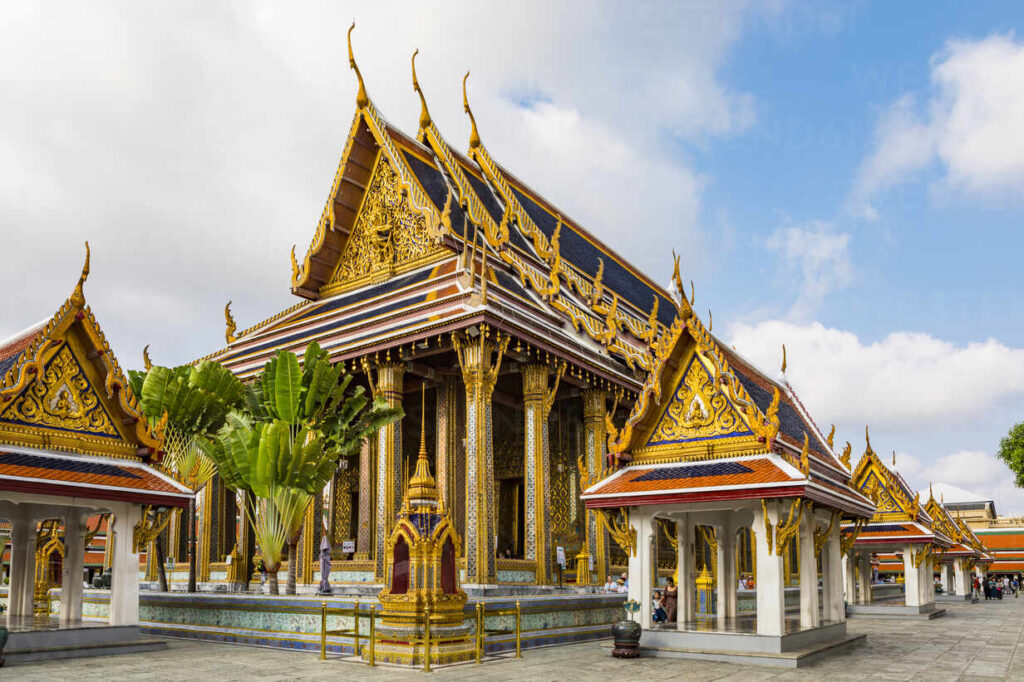
Architecturally breathtaking and spiritually profound, Wat Phra Kaew is the holiest site in Thai Buddhism and a powerful symbol of the Thai monarchy. At its center is the revered Emerald Buddha, while the adjacent Grand Palace, once home to Thai royalty, offers a glimpse into a world of elaborate ritual and strict social order.
The complex was established in 1782, the founding year of Bangkok as Thailand’s capital. Today, it stands as both the city’s most visited attraction and a sacred pilgrimage site for devout Buddhists.
The Emerald Buddha
Your first encounter upon entering Wat Phra Kaew is with the yaksha—towering guardian giants from the Ramakian, Thailand’s version of the Indian Ramayana. Beyond them lies a courtyard leading to the central bòht (ordination hall), where the Emerald Buddha is enshrined.
Despite its global fame, the statue is modest in size—just 66 cm tall—and placed high above the worshippers. The intricately gilded shrine often draws more visual attention than the small jade figure itself.
Its origins remain a mystery. First recorded in 15th-century Chiang Rai, the statue likely dates stylistically from the 13th or 14th century. Though named the “Emerald” Buddha, the statue is actually carved from green jade or jasper. Because of its royal significance, the statue is ceremonially dressed in seasonal robes—changed three times a year in a solemn ritual performed by the king himself.
Ramakian Murals
Circling the temple grounds is a 2-kilometre cloister adorned with 178 murals, illustrating the entire Ramakian epic. The story begins at the north gate and unfolds clockwise around the compound.
It follows Prince Rama and his bride, Sita, as they are exiled to the forest. When Sita is abducted by the demon king Ravana—disguised as a sage—Rama teams up with the loyal and cunning monkey king Hanuman to rescue her. The tale ends in dramatic battles, magical encounters, and ultimate triumph.
The mural walkway offers a quiet, shaded space—a welcome respite from the crowds and heat of the main courtyard.
Phra Mondop and Surrounding Structures
Commissioned by Rama I, the elegant Phra Mondop was built to store sacred Buddhist texts. While its lavish interior is closed to the public, its seven-tiered roof, silver-thread floor, and mother-of-pearl inlaid doors make it one of the world’s most ornate libraries.
Nearby, the Khmer-style Prasat Phra Thep Bidon and the golden Phra Si Ratana Chedi rise high into the sky, anchoring the spiritual and architectural grandeur of the compound.
Historical Background
King Rama I established Wat Phra Kaew in 1782 to house the Emerald Buddha, which he had seized from Vientiane (modern-day Laos). The statue was installed in the completed temple in 1784.
The Phra Ubosot (Chapel of the Emerald Buddha) was also commissioned by Rama I, designed in the Ayutthaya-period style with its multi-tiered lamyong roof and sacred boundary stones marking the ordination space.
Essential Tips for Visitors
Tickets: Entry is 500 Baht for foreign visitors; Thai nationals enter free. This price includes access to both Wat Phra Kaew and the Grand Palace. Tickets are sold at the entrance—anyone claiming the site is closed is likely a scammer.
Opening Hours: Daily from 8:30 am to 3:30 pm.
Getting There: Enter through the clearly marked third gate from Tha Chang Pier along Th Na Phra Lan, in Bangkok’s historic Phra Nakhon District.
Hydration: The large stone courtyards get extremely hot; bring water, as the on-site cafeteria isn’t always open.
Dress Code
As a deeply sacred site, Wat Phra Kaew enforces a strict dress code:
Shoulders and legs must be covered.
No shorts, sleeveless tops, crop tops, or sheer clothing.
Those dressed inappropriately will be redirected to a changing area and provided with sarongs, which may increase wait times.

Mount Fuji (Fuji-san) is one of Japan’s most iconic and sacred landmarks—celebrated in poetry, art, and the hearts of generations. Its near-perfect cone shape has inspired countless visitors, and every year, hundreds of thousands make the ascent as part of a time-honored pilgrimage. Even if you don’t hike to the summit, simply viewing Japan’s tallest peak is a must-do experience.
There’s a well-known saying in Japan: climbing Mt Fuji once makes you wise; doing it twice, foolish. While the trail itself is stark and the summit often hidden by clouds, the personal reward and cultural significance make the climb worthwhile. Around 300,000 hikers take on this challenge each year during the official season from 1 July to 31 August, occasionally extended to 10 September depending on conditions.
Mount Fuji is divided into 10 stations, from the base to the summit. Most climbers begin at one of the Fifth Stations, which are accessible by road. The Yoshida Trail is the most popular route, thanks to its direct bus connection from Shinjuku Station and a good number of mountain huts with food, toilets, and water along the way.
Climb duration (Yoshida Trail):
Ascent: 5–6 hours
Descent: 3 hours
Crater circuit (optional): 1.5 hours
Other trails include Subashiri, Gotemba, and Fujinomiya—with Gotemba being the steepest and a good option for travelers from the Kyoto–Osaka area.
For a more traditional challenge, consider the Old Yoshidaguchi Trail, a 19km trek starting at Fuji Sengen Shrine in Fuji-Yoshida. It connects with the modern Yoshida Trail higher up the mountain.
During peak season, trails can get crowded. To avoid the rush, opt for a weekday hike, start early, or spend a night in a mountain hut to reach the summit by sunrise—often the best time for clear views.
Note: Climbing outside the official season is strongly discouraged due to unpredictable weather and the closure of first-aid stations. However, some still hike during this time. If you do, start at dawn, descend by early afternoon, and register with local police (forms are available at Kawaguchi-ko or Fuji-Yoshida Tourist Information Centers).
Tip: Hike slowly to avoid altitude sickness, and consider using hiking poles to protect your knees—especially on the descent.
Above the Fifth Station, you’ll find many simple mountain huts offering hot meals and resting space. While basic (often just a shared sleeping area with blankets), reservations are highly recommended—especially on weekends. Be sure to cancel if you can’t make it, or you may still be charged.
Popular huts include:
Fujisan Hotel
Higashi Fuji Lodge
Taishikan
Note: Camping on the mountain is not allowed, except at a designated site near the Fuji Subaru Line Fifth Station (also known as Kawaguchi-ko Fifth Station).
No special permit is required to climb Mt Fuji.
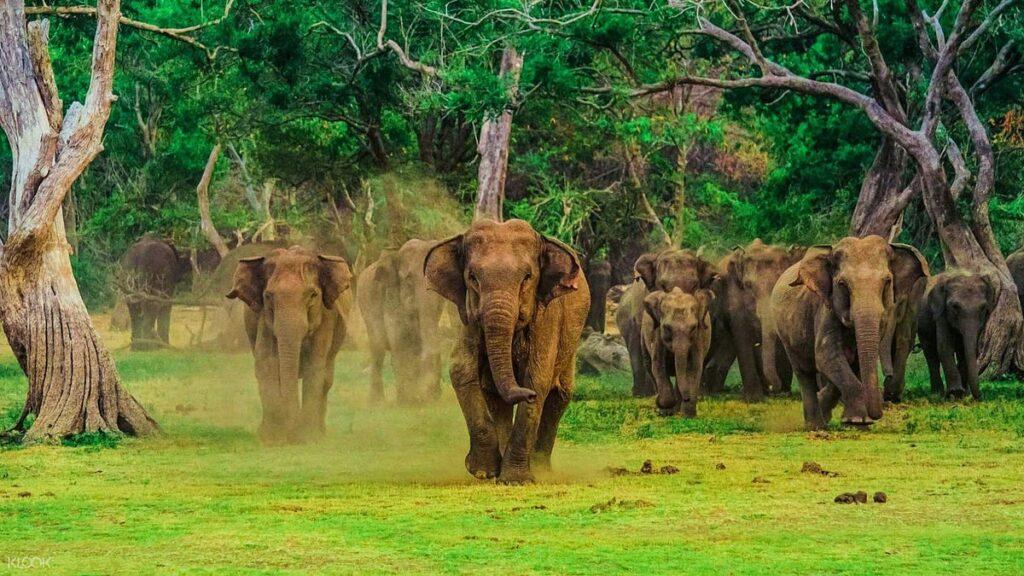
Home to herds of elephants, wild buffalo, sambar deer, spotted deer, and giant squirrels, Uda Walawe is one of Sri Lanka’s premier national parks. In fact, when it comes to elephant sightings, it often outshines even the renowned parks of East Africa. Spanning 308.2 square kilometers around the Uda Walawe Reservoir, the park features sparse vegetation that adds a stark, striking beauty—while also making wildlife viewing easy and accessible.
The park’s main draw is its elephant population, with around 600 roaming in herds as large as 50. Much of the park is surrounded by an elephant-proof fence designed to prevent elephants from straying into populated areas and to keep cattle out. However, elephants still migrate through the unfenced borders. The ideal times to witness these gentle giants are from 6:30 AM to 10 AM and again between 4 PM and 6:30 PM.
Besides elephants, Uda Walawe is also home to mongooses, jackals, sloth bears, crocodiles, water monitor lizards, and even the occasional leopard. There are over 30 species of snakes and around 210 species of birds—many of which are migratory and arrive between November and April.
Planning Your Safari
The park entrance lies 12 km from the Ratnapura–Hambantota road turn-off and 21 km from Embilipitiya. Tickets are sold 2 km past the entrance gate. Most visitors book safaris through their hotel or guesthouse, though you can also hire a 4WD vehicle at the gate—expect to pay around Rs 3500 for a half-day trip for up to eight people. The last tickets are usually issued by 5 PM.
A park guide is included in the ticket price. These guides are often impressively sharp-eyed and knowledgeable. However, unless otherwise requested, safaris tend to focus on racing between elephant herds, often missing out on the park’s many other fascinating creatures.
For a more fulfilling experience, let your guide and driver know in advance that you’re interested in observing a wider range of wildlife. When you stop, ask your driver to turn off the engine—this allows you to enjoy the natural sounds of the forest rather than the vehicle’s rumble. Also, keep in mind the park’s growing issue of crowding around animals. Ideally, no more than five vehicles should be present at a sighting. If a crowd forms, ask your driver to hold back—or explore quieter corners of the park. Tipping your guide and driver is customary.
Where to Stay
There’s a good range of accommodation near the park, though rates are generally higher than in coastal or highland regions. While day tours are available from Ella, Tissamaharama, Ratnapura, and various southern resorts, these typically occur during the hottest part of the day—when wildlife is least active. To make the most of your visit, consider staying overnight so you can join both morning and evening safaris.
Recommended nearby accommodations include Silent Bungalow, Superson Family Guest, and Elephant Safari Hotel.
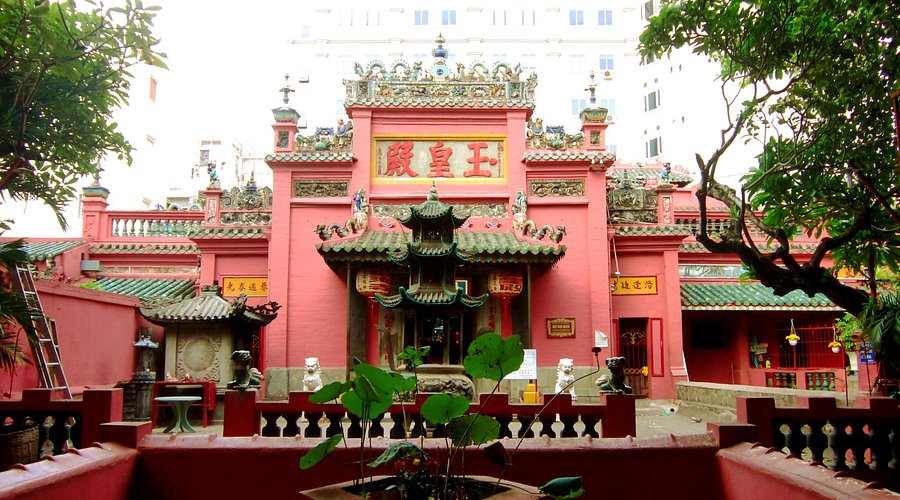
Constructed in 1909 to honour the supreme Taoist deity—the Jade Emperor (Ngoc Hoang), also known as the King of Heaven—this temple stands as one of Ho Chi Minh City’s most atmospheric spiritual sites. Within its dim, incense-filled chambers, phantasmal deities and fearsome heroes come to life in dramatic papier-mâché sculptures and intricate woodcarvings.
The thick scent of incense (huong) hangs in the air, partially veiling the ornate carvings and tilework that adorn the temple’s roof and walls. Figures from both Taoist and Buddhist traditions share the space, reflecting the temple’s blended spiritual influences.
This syncretism is echoed in the temple’s alternative name, Phuoc Hai Tu (福海寺; Sea of Blessing Temple), which carries a distinctly Buddhist message. The Chinese inscription in the main hall, Phat Quang Pho Chieu (佛光普照), translates to “The light of Buddha shines on all.”
Exploring the Temple
Inside the main sanctuary, visitors are greeted by two towering Taoist generals—guardians of the altar. On the right stands the 4-metre-tall warrior who vanquished the Green Dragon, shown trampled beneath his feet. On the left, his counterpart conquers the White Tiger in a similarly symbolic display.
At the heart of the sanctuary is the resplendent Jade Emperor, cloaked in luxurious robes and enveloped in clouds of incense smoke. He is flanked by the formidable Four Big Diamonds (Tu Dai Kim Cuong), his loyal guardians, reputed to be as unbreakable as their names suggest.
To the left of the Emperor’s chamber, another room awaits. Here, Thanh Hoang, the Chief of Hell, holds court. His red steed stands to the side, while surrounding figures represent divine agents of karma—dispensing rewards for good deeds and punishments for evil ones.
One of the most haunting sections is the Hall of the Ten Hells, where intricately carved wooden panels depict the fates of wrongdoers across the Ten Regions of the Underworld. Nearby, women line up before an effigy of the City God, whose hat bears the promise: “At one glance, money is given.” In a captivating ritual, visitors offer money, rub red paper against his hand, and wave it over a candle flame, seeking blessings.
Beyond this lies a curious chamber featuring 12 vividly dressed women, each accompanied by children and symbolising traits—both virtuous and flawed, such as the woman sipping wine. These figures represent the 12 signs of the Chinese zodiac and are overseen by Kim Hoa Thanh Mau, revered as the Mother of All Women.
Upstairs, you’ll find a serene hall dedicated to Quan Am, the Buddhist Goddess of Mercy, facing a portrait of Dat Ma (Bodhidharma), the bearded Indian sage who founded Zen Buddhism.
Outside, a turtle pond ripples with life—some of the turtles’ shells inscribed with lucky symbols, adding a final touch of charm to the sacred space.
Visitor Information
Entry: Free of charge (donations welcome at various points)
Dress Code: Modest attire recommended—cover shoulders and knees
Best Time to Visit: Early morning, to avoid the crowds
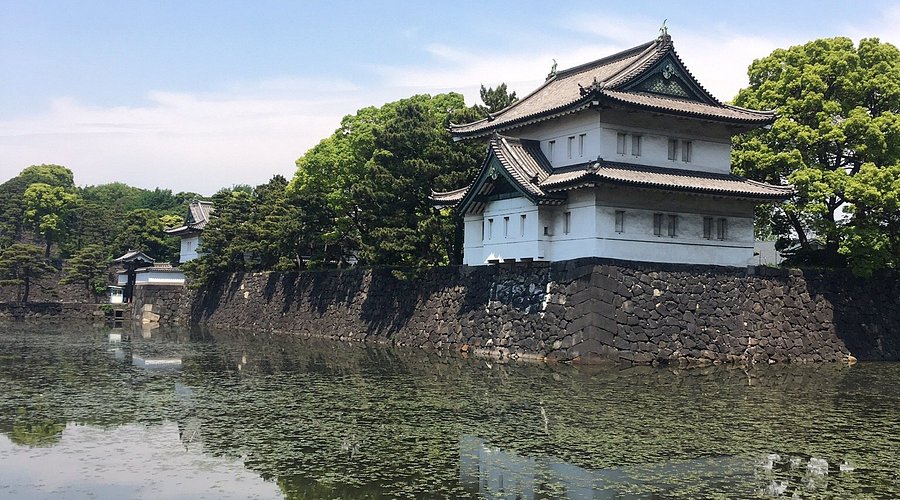
The Imperial Palace stands on the former site of Edo-jō, once the grand castle of the Tokugawa shogunate. At its peak, Edo-jō was the world’s largest fortress, though today only its moats and imposing stone walls remain. The palace complex spans 3.4 square kilometers, most of which is closed to the public as it serves as the emperor’s residence. However, the Imperial Household Agency offers free guided tours of select inner areas.
Surrounding the palace is Kōkyo-gaien, a 115-hectare national garden featuring scenic green spaces, moats, and museums. The Imperial Palace East Garden is open to the public year-round without a guide and offers a peaceful retreat within the city.
After the fall of the Tokugawa shogunate, the emperor moved to Tokyo, and Edo-jō became the Imperial Palace (Kōkyo). Much of the original structure was destroyed by fire in 1873, with a new palace completed in 1888. The current buildings, rebuilt in a modest Japanese modernist style during the 1960s following WWII air raids, include the Kyūden, the main palace housing the throne room and the Matsu-no-Ma (Pine Chamber).
Tours are held Tuesday to Saturday (excluding public holidays, late July mornings through August, and from 28 December to 4 January), at 10:00 am and 1:30 pm. Arrive at Kikyō-mon Gate at least 10 minutes early. Tours last around 1 hour 15 minutes.
Reservations can be made up to a month in advance through the Imperial Household Agency website, by phone, post, or in person at Kikyō-mon. Same-day registration is possible if space permits. Bring photo ID. The tour passes the Kyūden, the post-WWII palace building completed in 1968. Commentary is in Japanese, but an app with multilingual guides is available.
Even without a tour, visitors can explore Kōkyo-gaien Plaza. Head to its southwest corner to see the iconic Nijū-bashi (Double Bridge) and Megane-bashi (Eyeglass Bridge), with the Fushimi-yagura watchtower rising behind them.
The East Garden is open to all without reservations. Upon entry, visitors receive a token which must be returned when leaving.
WhatsApp us